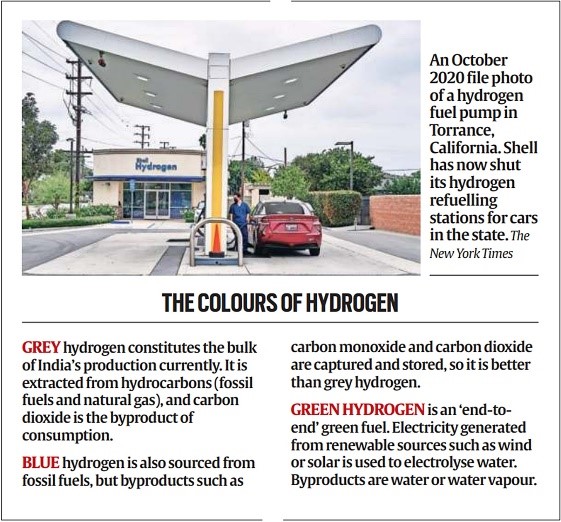
Disclaimer: Copyright infringement not intended.
Context:
- India is embarking on pilot projects aimed at testing the viability of green hydrogen as a vehicle fuel and establishing secure supporting infrastructure, including refuelling stations.
ALL ABOUT GREEN HYDROGEN: https://www.iasgyan.in/daily-current-affairs/green-hydrogen-47
GREEN HYDROGEN STANDARDS: https://www.iasgyan.in/daily-current-affairs/green-hydrogen-standards#:~:text=It%20is%20a%20colourless%2C%20odourless,%2C%20solar%2C%20and%20hydroelectric%20power.
Big Indian Commercial Vehicle Manufacturers Embrace Hydrogen Technology
- Major players in the Indian commercial vehicle sector, such as Tata Motors, Volvo Eicher, and Ashok Leyland, are intensifying their efforts to develop hydrogen-powered trucks and buses.
- This involves a significant commitment to research and development, as well as the expansion of manufacturing capacities.
Scaling Up Green Hydrogen Production by Indian Energy Companies
- Indian energy companies are actively working to scale up the production of green hydrogen while simultaneously striving to reduce costs.
- Their goal is to make green hydrogen competitive with other fuels in terms of affordability.

Anticipated Role of Hydrogen in India's Transportation Sector
- Hydrogen is expected to play a pivotal role in India's transportation sector in the coming years.
- Given India's status as a large and growing market for both vehicles and energy, the widespread adoption of green hydrogen as a vehicular fuel holds considerable promise for the country.
Environmental and Economic Benefits of Green Hydrogen Adoption
- The adoption of green hydrogen offers substantial environmental benefits, including significant reductions in emissions to mitigate global warming and climate change.
- India stands to gain from these advantages, which range from pollution reduction and achievement of climate goals to decreased reliance on costly fossil fuel imports.
- Additionally, there is a notable business opportunity for India to establish itself as a global hub for the production and export of green hydrogen.

Understanding Green Hydrogen
- Hydrogen, being colorless, is termed "green" based on its production method and the energy source used.
- Green hydrogen is produced through the electrolysis of water, utilizing renewable energy to split water into hydrogen and oxygen.
- This process is considered virtually emission-free, as it is powered by renewable energy, utilizes water as a feedstock, and emits no carbon during consumption.
Contrasting Green and Grey Hydrogen
- In contrast, grey hydrogen, which constitutes the majority of industrial hydrogen production, is generated from natural gas through energy-intensive processes, resulting in high carbon emissions.
- Despite differences in production pathways and emissions, green hydrogen shares fundamental characteristics with other forms of hydrogen.
Transport Sector Scheme for Green Hydrogen
- The Ministry of New and Renewable Energy (MNRE) has introduced a scheme focused on leveraging green hydrogen as a transportation fuel. The scheme, outlined in February, aims to achieve several key objectives:
- Technical Feasibility and Performance Validation: Assessing the viability and performance of green hydrogen as a transportation fuel.
- Economic Viability Evaluation: Evaluating the economic feasibility of vehicles powered by green hydrogen.
- Demonstration of Safe Operation: Demonstrating the safe operation of hydrogen-powered vehicles and refuelling stations.
Implementation Process
- The Ministry of Road Transport & Highways will oversee the implementation of the scheme, appointing a designated agency to execute pilot projects. Interested parties, either companies or consortia, will be invited to submit proposals for pilot projects.
- Following a recommendation from a Project Appraisal Committee, the MNRE will approve viability gap funding (VGF) for selected projects.
- The amount of VGF will be determined based on the specific needs, merits, and feasibility of each project.
- The executing agency will be responsible for completing the pilot project within a two-year timeframe.
VGF: https://www.iasgyan.in/daily-current-affairs/india-infrastructure-project-development-fund-scheme-iipdf-scheme#:~:text=Viability%20Gap%20Funding%20is%20designed,make%20the%20project%20financially%20viable.

Hydrogen Internal Combustion Engine (ICE) Vehicles
- A hydrogen ICE vehicle operates by utilizing hydrogen through combustion, similar to traditional cars fueled by diesel or petrol. However, unlike conventional vehicles, hydrogen ICE vehicles produce no carbon emissions.
Hydrogen Fuel Cell Electric Vehicles (FCEVs)
- Hydrogen FCEVs function by electrochemically converting hydrogen stored in a high-pressure tank into electricity.
- This process results in water as the only byproduct. Research indicates that while hydrogen combustion in ICE vehicles produces no carbon emissions, it is less energy-efficient compared to the conversion of hydrogen into electricity in fuel cells.
Weight Considerations and Payload Capacity
- Compared to Battery Electric Vehicles (BEVs), where the battery constitutes the heaviest component, hydrogen FCEVs are typically lighter. This is because hydrogen is a lighter element, and a fuel cell stack weighs less than an EV battery.
Advantages for Heavy-Duty Trucks
- Hydrogen fuel cell technology presents a viable alternative to EV battery technology, particularly for heavy-duty trucks.
- The lighter weight of hydrogen FCEVs allows for increased payload capacity, without the emissions associated with diesel combustion.
- Research indicates that long-haul FCEVs can carry freight amounts comparable to diesel trucks, while long-haul BEVs suffer from a weight penalty of up to 25% due to heavier batteries.
Promise of Green Hydrogen
- With the imperative to reduce carbon emissions in the transportation sector while maintaining revenue-generating payload capacity, green hydrogen emerges as a promising solution.
- Its potential to power hydrogen fuel cell vehicles offers a pathway towards sustainable transportation, particularly for heavy-duty applications.
Prohibitive Production Costs
- The foremost challenge hindering the large-scale use of green hydrogen in the transportation sector is the prohibitive cost of production.
- Despite advancements in technology and scaling-up of production, costs remain high.
Storage and Transportation Challenges
- Challenges related to storage and transportation at scale pose significant hurdles.
- Innovations in technology are needed to address these challenges and make green hydrogen more feasible for widespread use.
Competing with Battery Electric Vehicles (BEVs)
- Green hydrogen-powered vehicles face hurdles in competing with four-wheel BEVs, primarily due to fuel costs and the need for extensive supporting infrastructure.
- Recent developments, such as the closure of hydrogen refuelling stations by Shell in California, underscore the challenges faced by the hydrogen fuel industry.
Specialized Cylinder Development
- Manufacturers of commercial vehicles have highlighted challenges related to high-pressure storage cylinders for green hydrogen.
- Specialized cylinders capable of safely storing high-pressure hydrogen need to be developed to facilitate the adoption of green hydrogen as a transport fuel.
Safety Concerns and Handling Standards
- Hydrogen's extreme flammability necessitates special care in handling, especially at retail stations.
- Robust safety standards must be developed and implemented to ensure safe handling and storage compared to traditional fuels like diesel, petrol, or CNG.
Viability of Infrastructure and Technological Advancements
- The existing natural gas pipeline infrastructure is not considered viable for hydrogen transportation.
- Furthermore, advancements in battery technologies reducing the weight of EV batteries pose a long-term challenge to the viability of green hydrogen-powered heavy-duty commercial vehicles.
- Ongoing innovation is crucial to address these challenges and ensure the long-term sustainability of green hydrogen as a transportation fuel.
|
PRACTICE QUESTION
Q. Discuss the potential of green hydrogen as a sustainable alternative fuel in India's transportation sector. Examine the challenges and opportunities associated with the adoption of green hydrogen technology, and suggest policy measures to promote its widespread use.
|









